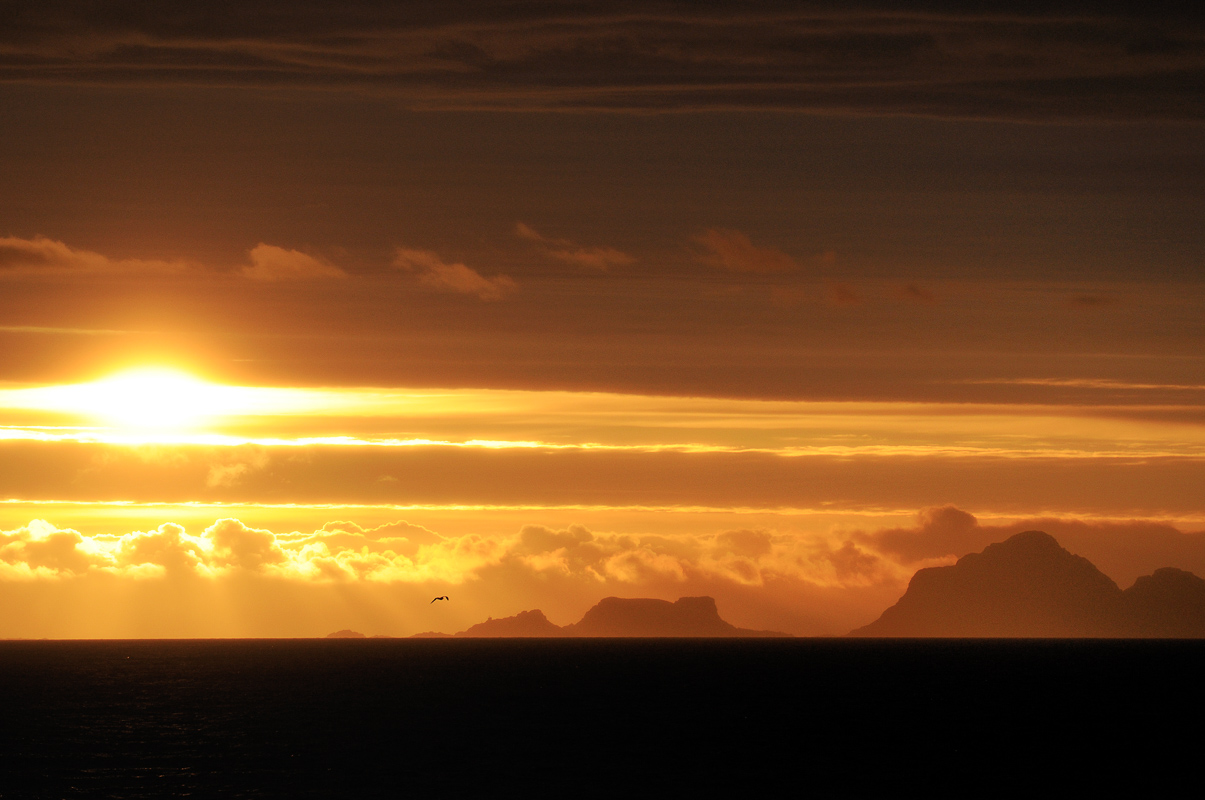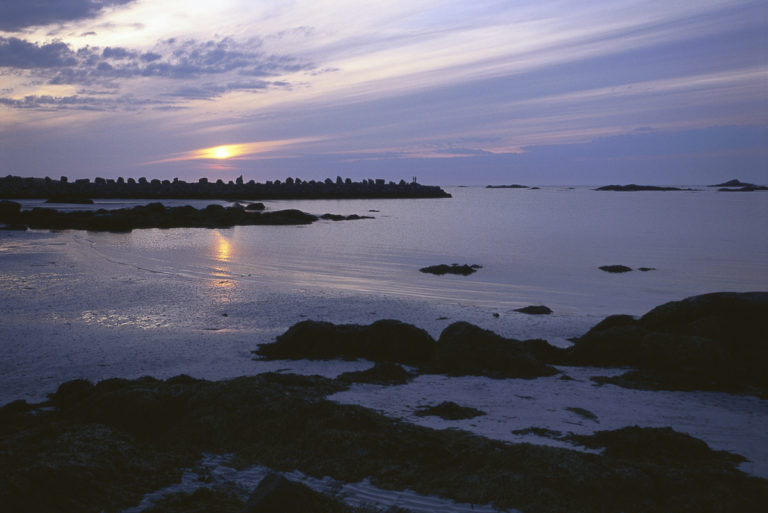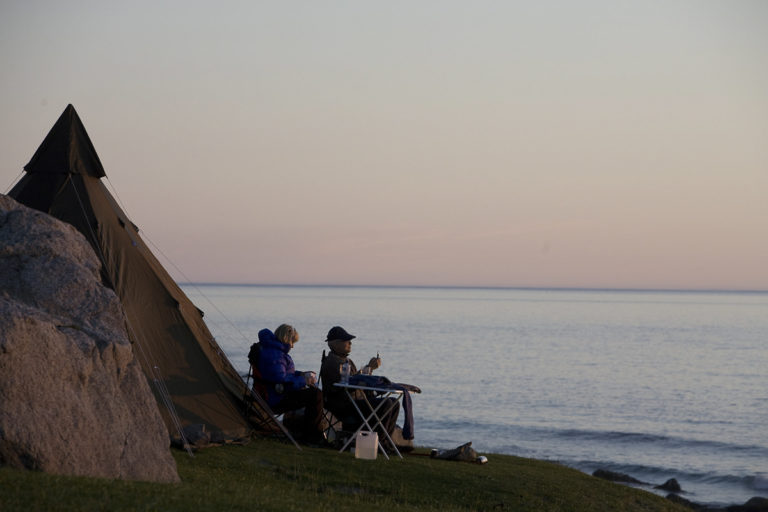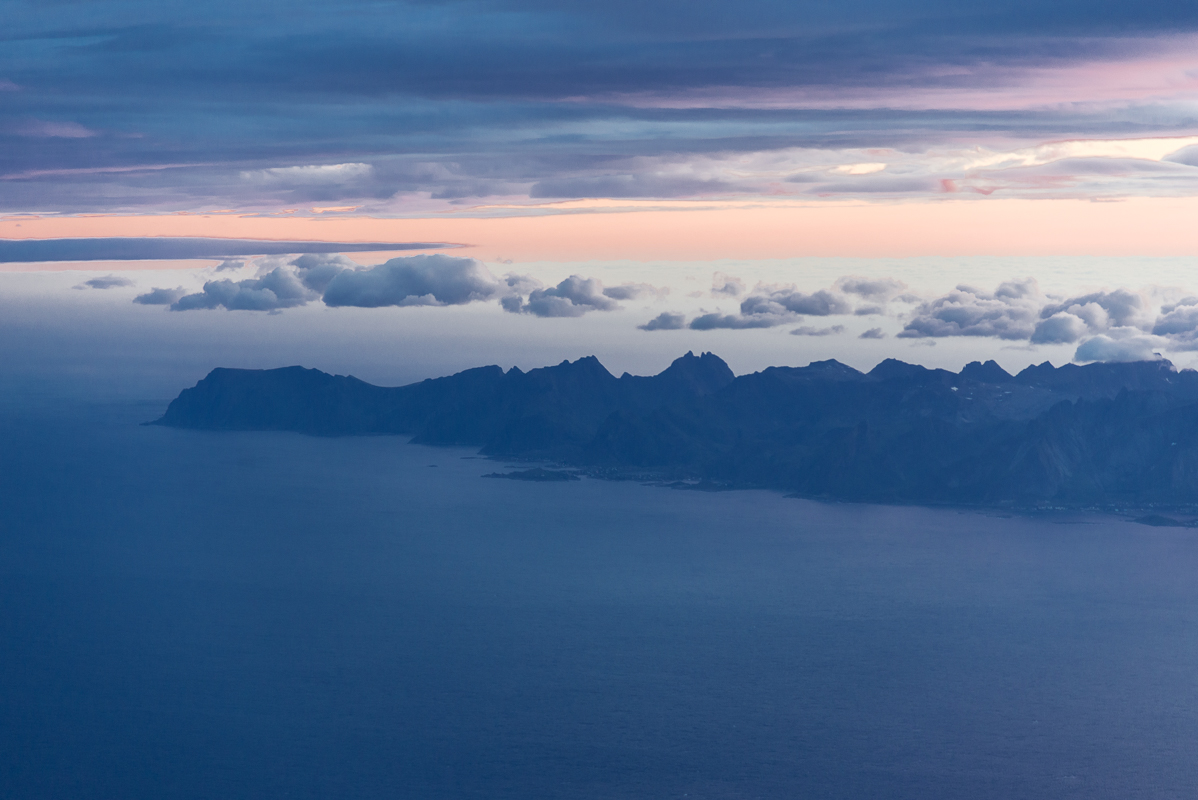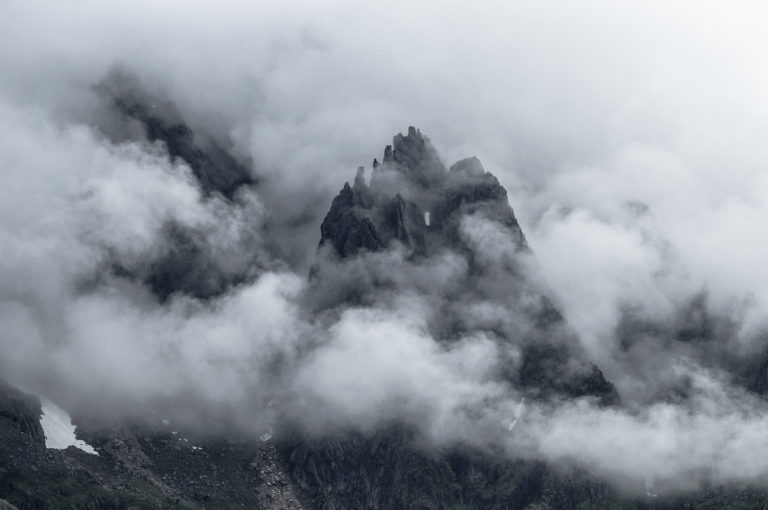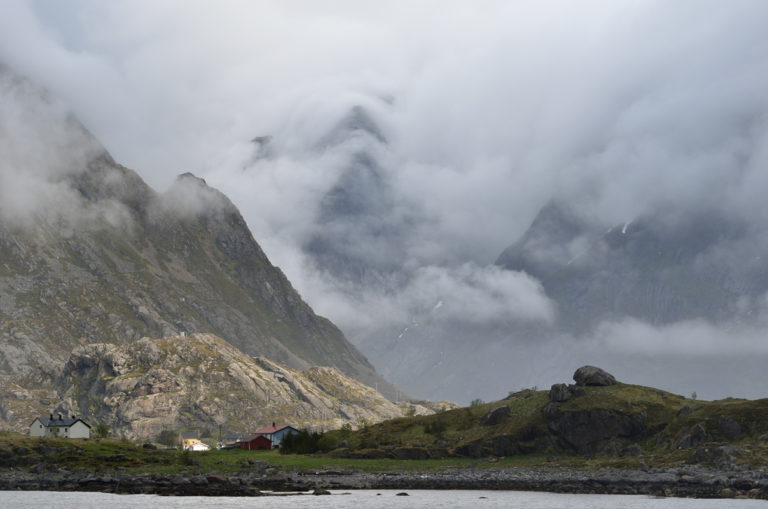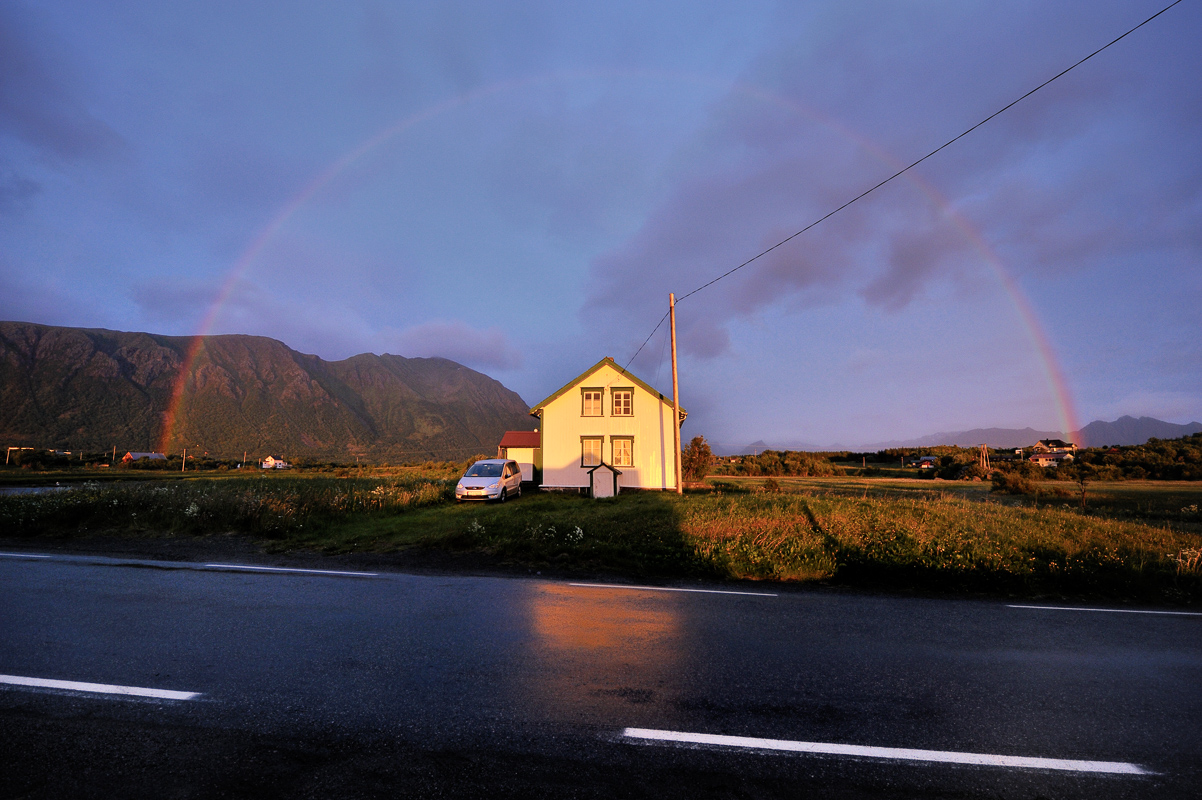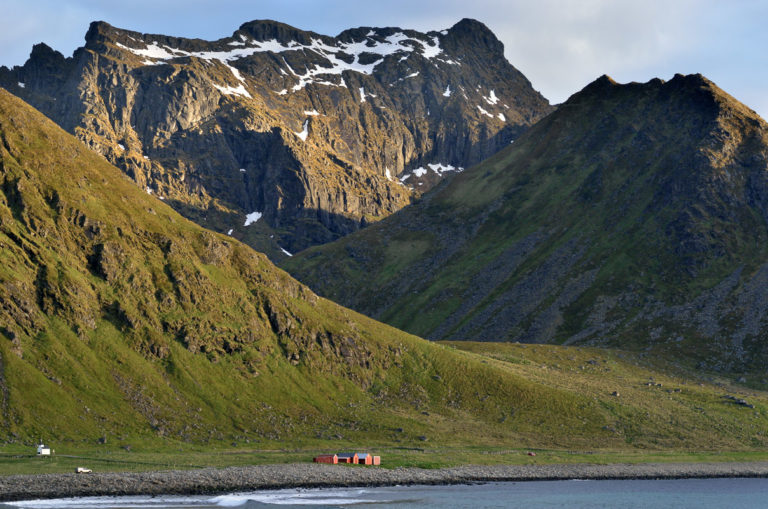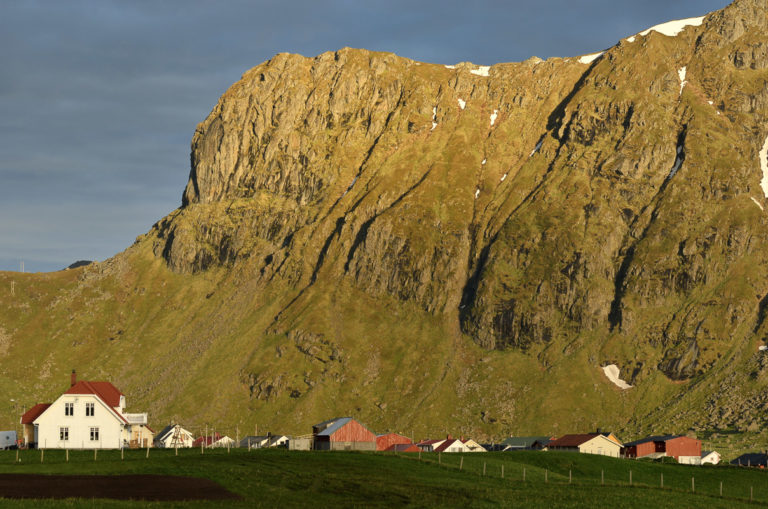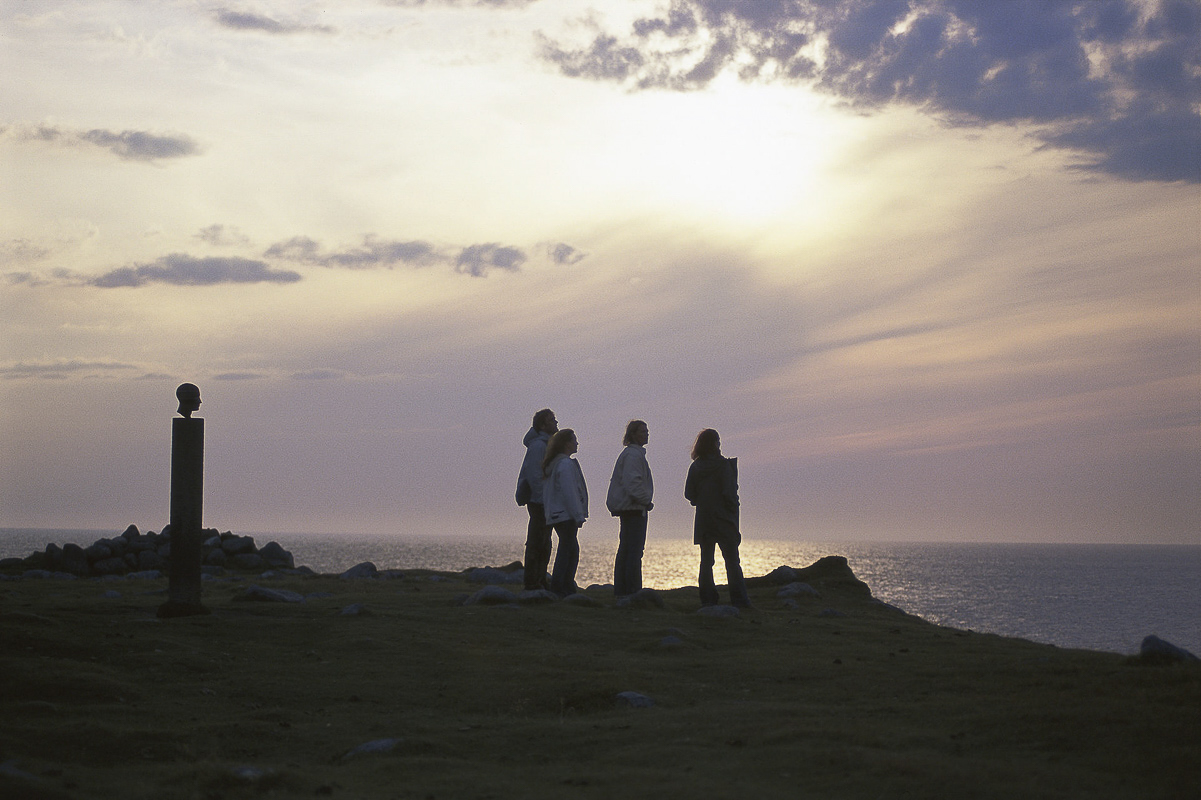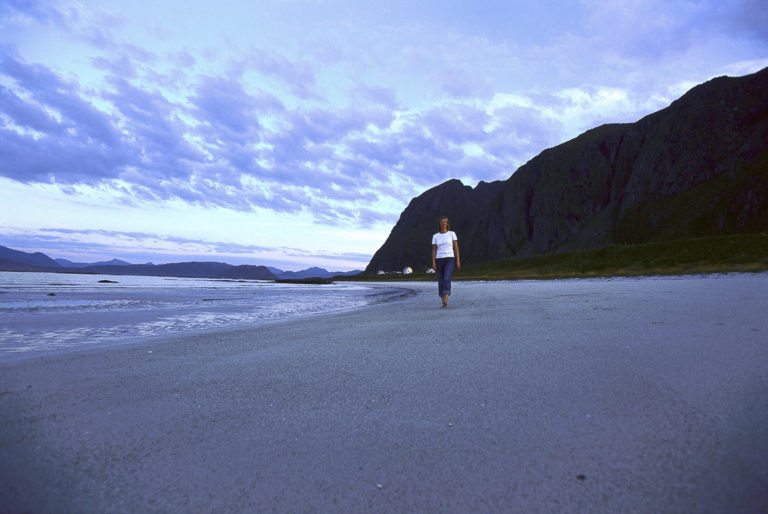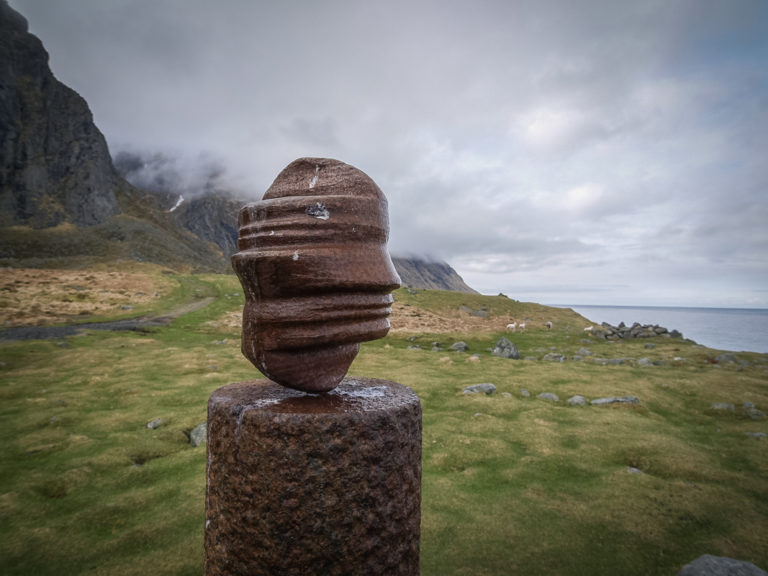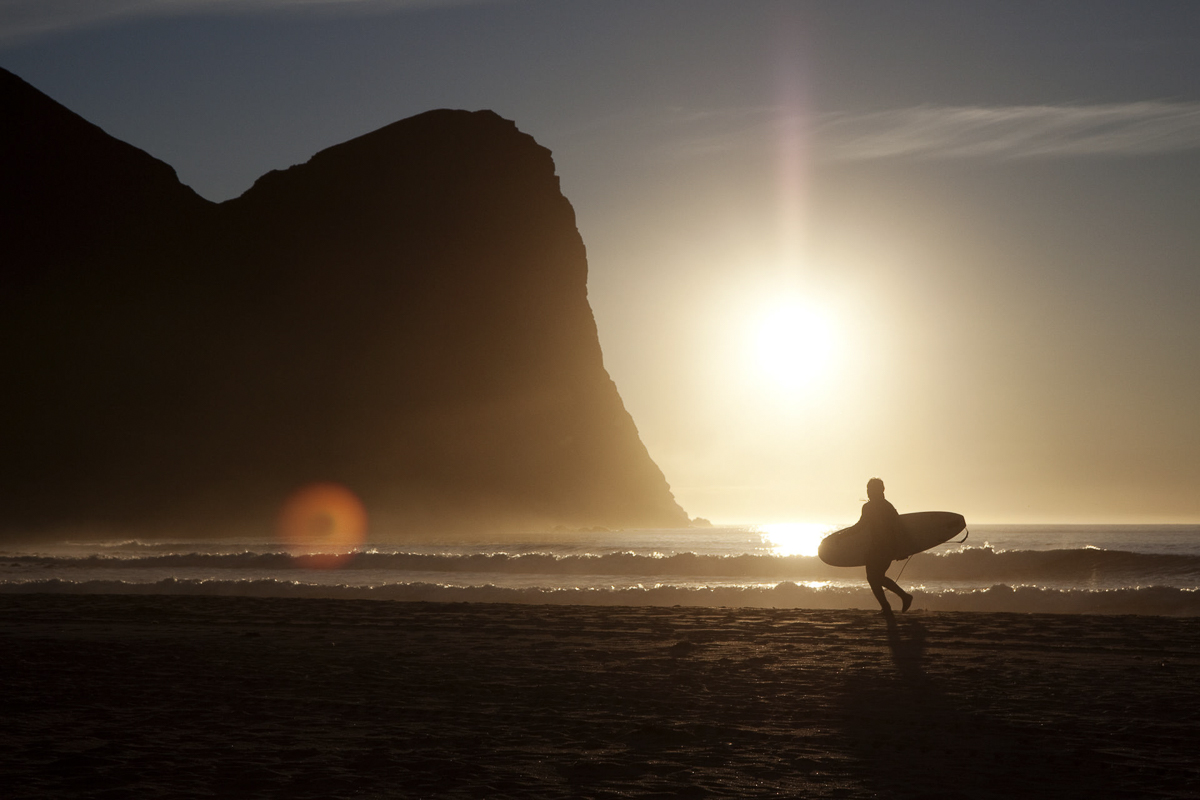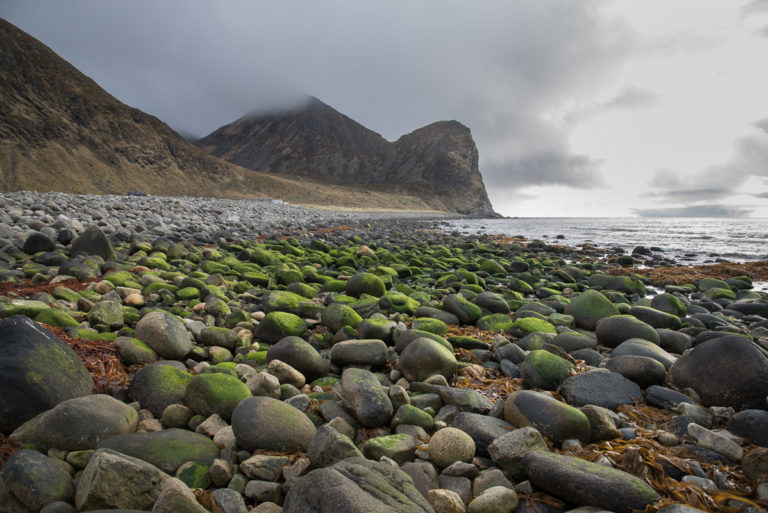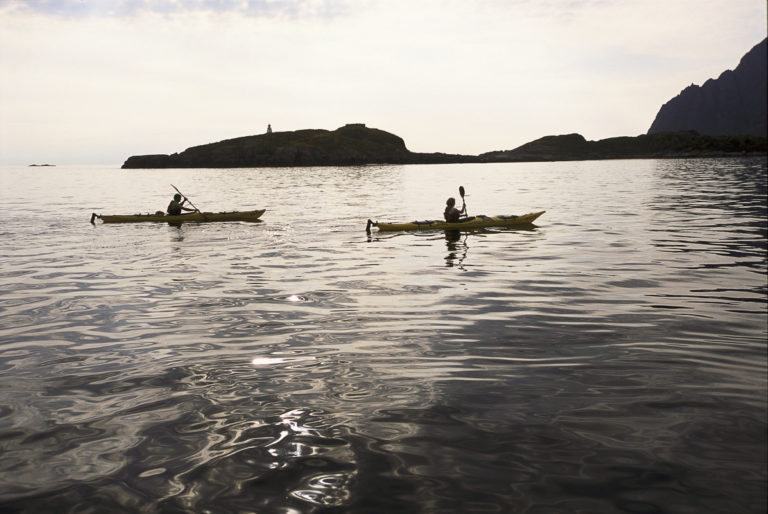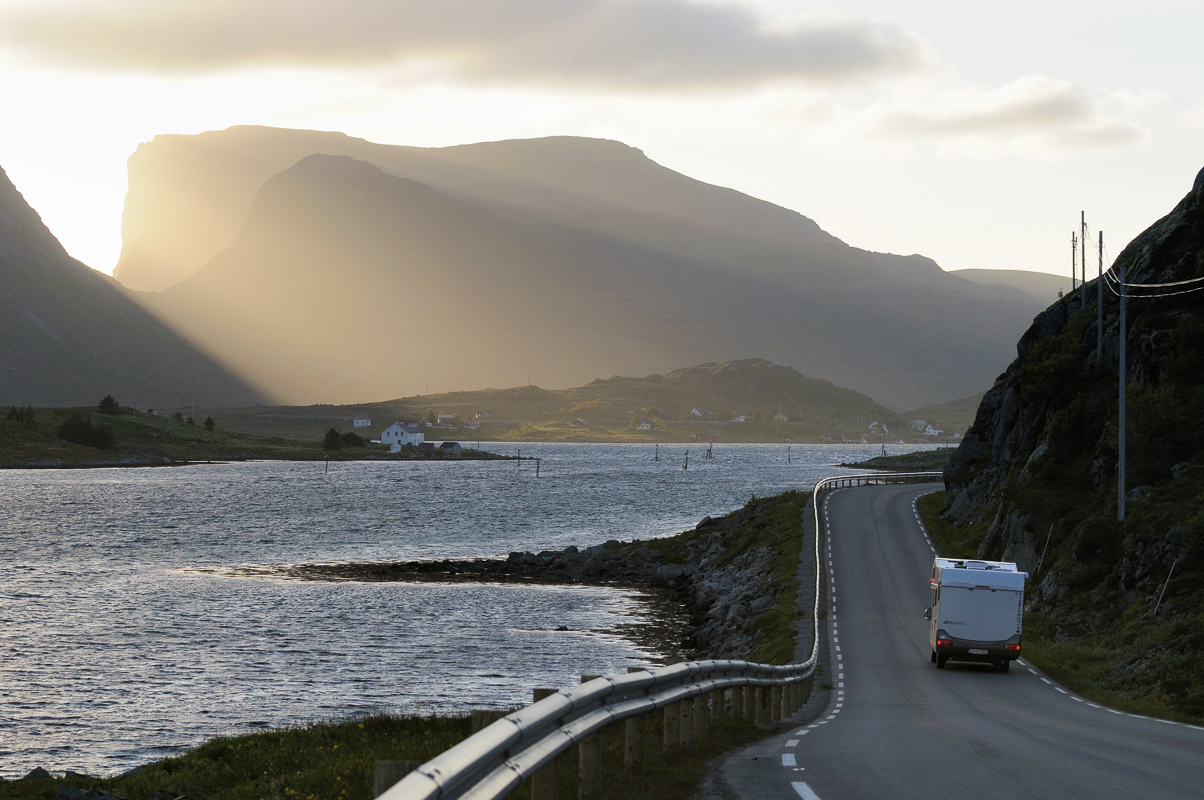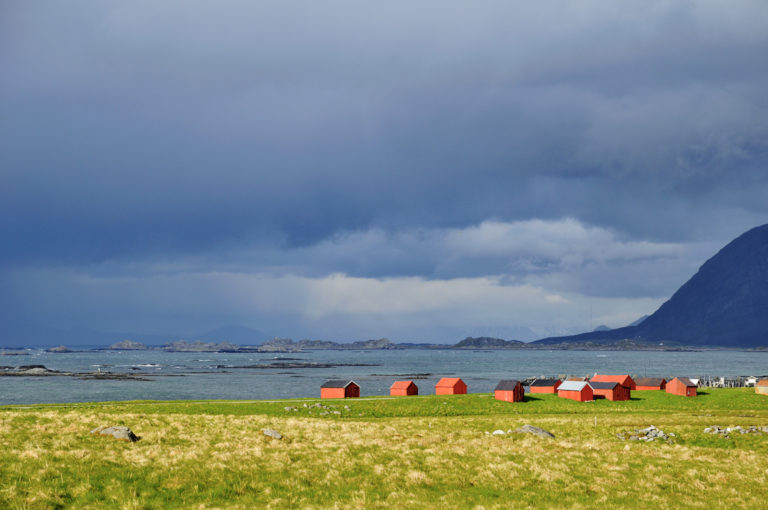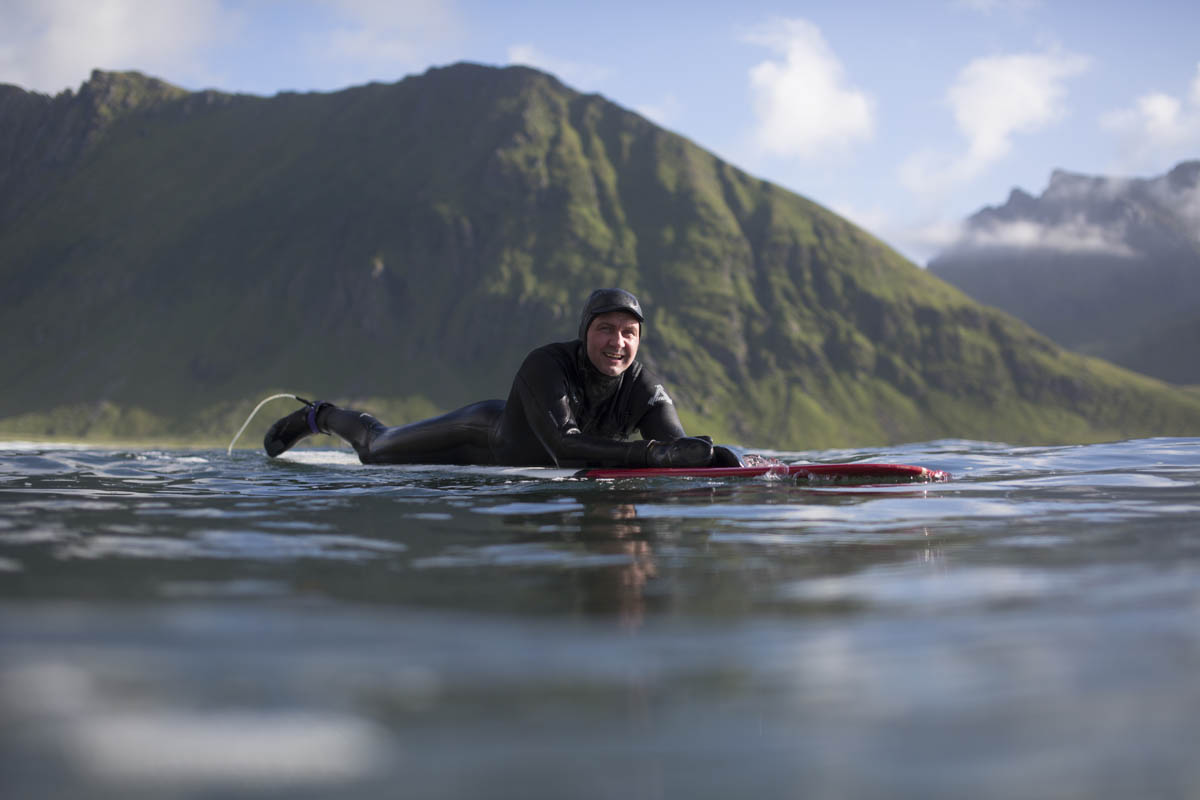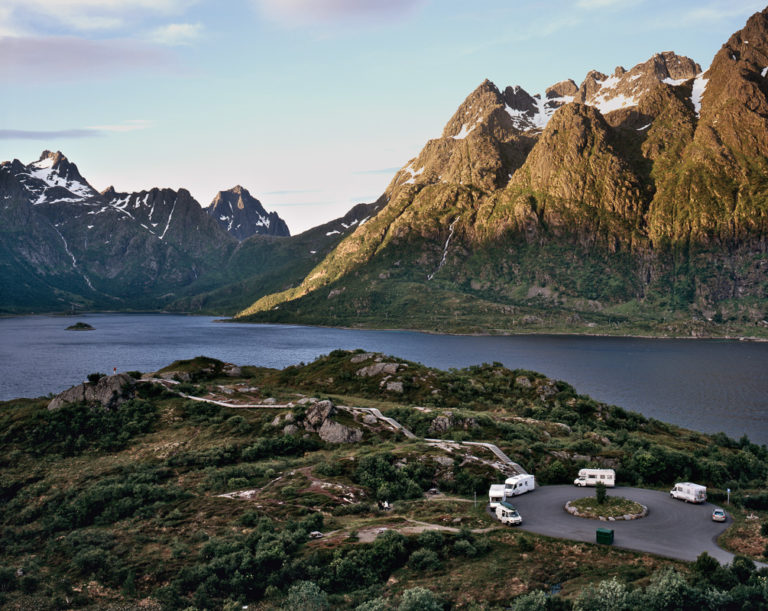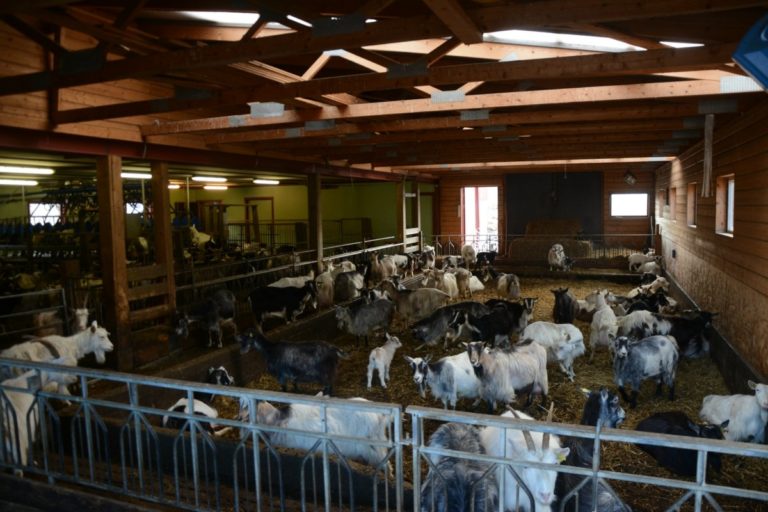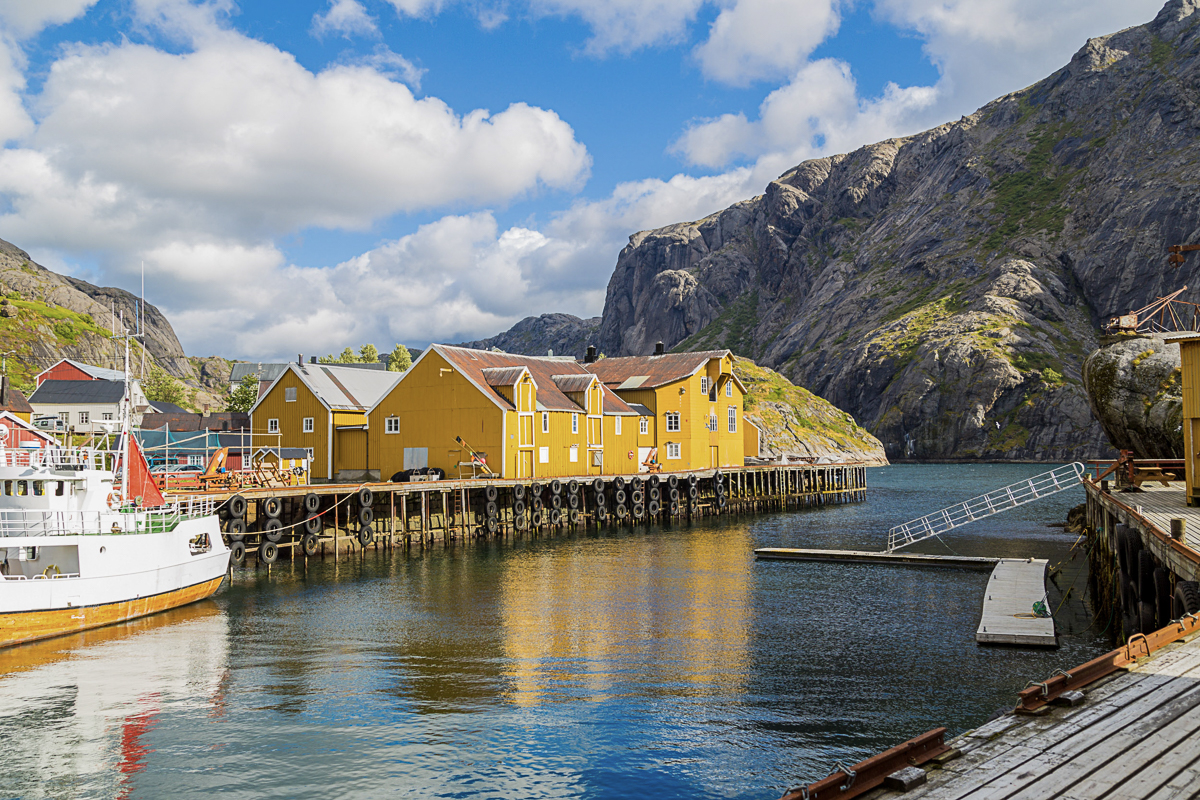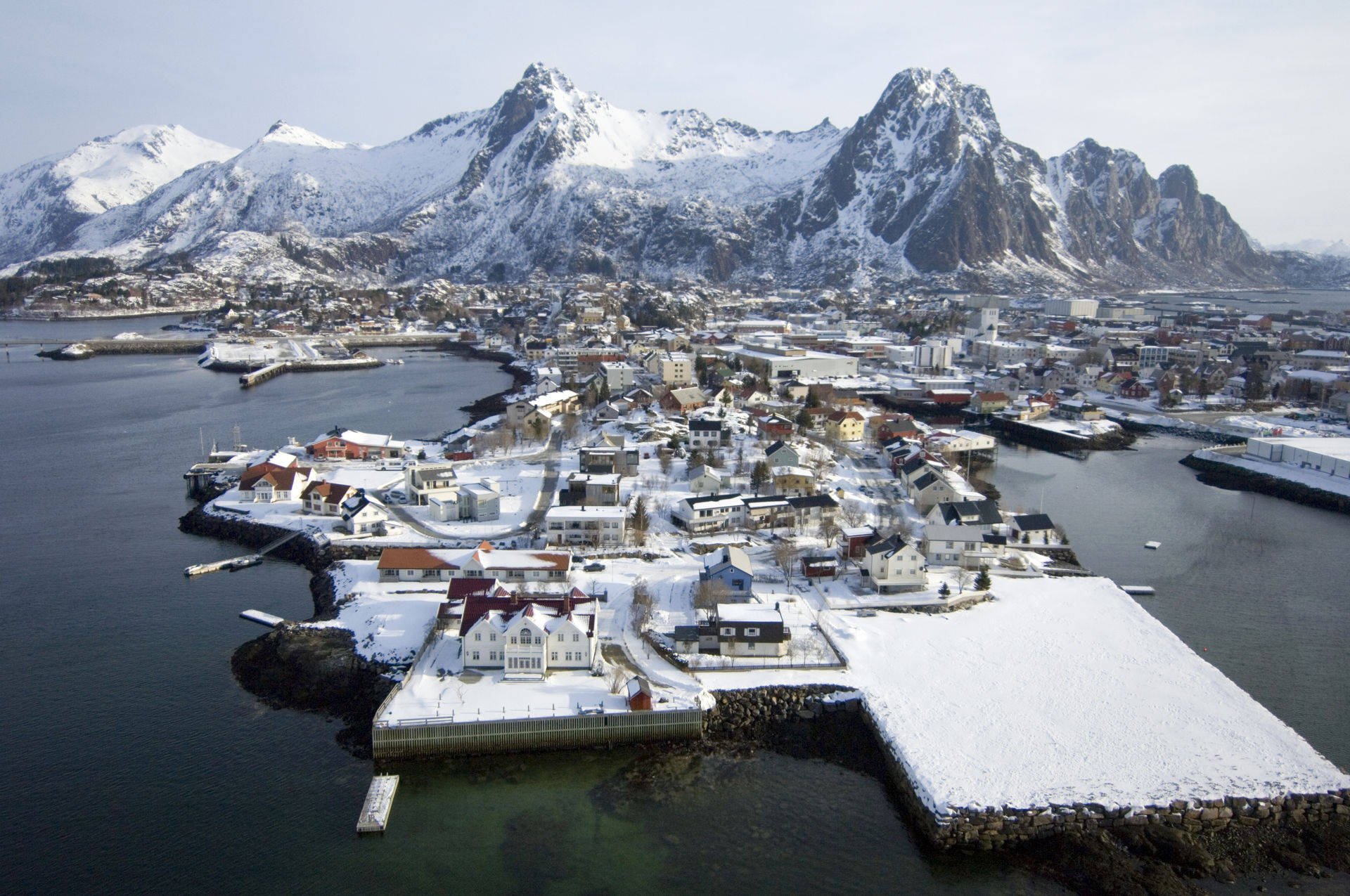The Lofoten islands are well north of the Arctic Circle, meaning that they have Midnight Sun for up to nearly two months. However, the Midnight Sun has to play hide and seek with the towering mountains from its low position over the ocean in the north. You thus have to explore a little to find it, but any exploration in the beautiful and endlessly varied landscape of Lofoten is a sheer delight.
You have to go to the outer coast to see the Midnight Sun
The majestic peaks of the Lofoten Islands give protection against the cold northern winds to the colourful fishing villages lining the south-eastern coast of the archipelago. The north-western side is more exposed and less populated. At Midnight in summer however, the northwestern coast is where you want to be, as the friendly fishing villages south and east are in the shadows. From the dockside in villages like Reine, Nusfjord and Henningsvær, you can see the mountain tops bathed in sunshine, and the peaks on the mainland are covered in a golden hue. But seeing the eye of the sun? Nope, for that you have to head north.
Find yourself a beautiful beach on the north western side
The outer coast is rough and weather-beaten, with a lot fewer settlements. In inlets and coves, there are fabulous beaches with soft sand, and the headlands are rocky and stony. The tiny villages have a feel of romantic melancholy contrasting with the bigger, livelier ones on the “inside”. Watching north, there is no land until the North Pole, the perfect location to see the Midnight Sun.
The Lofoten Islands are far from sun-drenched
There is no hiding that the weather in Lofoten is highly entertaining. Rain and fog shroud the peaks in mystery, wind closes the bridges and tempeatures drop to single digits even in the middle of summer. When the cool, northwestern winds blow, one often has crisp, clear and nippy days. The occasional heat wave with temperatures soaring to +25 of course drive people to the sandy, otherwise deserted beaches. And even if the days have been wet and cool, the weather often improves in the evening. This is especially true on the Northern coast, where you often see the sun breaking through late in the evening. So even if it looks hopeless, go north, it would be too bad to miss it!
Kvalvika and Ryten are the Instagram favourites
A 30 minute’s walk takes you to the Kvalvika beach on the northern tip of the island of Moskenesøy. The beach has smooth, white sand, surrounded by precipitous cliffs. Don’t, however, expect to be there alone, this is firmly on the Instagram list. The nearby mountain of Ryten has a viewpoint overlooking the beach, and going up here will take you another hour and a half.
Uttakleiv
Another darling for the instagrammers is the beach at Uttakleiv. This beach on the northwestern side of the Vestvågøy Island is found under the Himmeltinden (“Heaven’s peak”) and has sandy beaches, cliffs and views to the nearby mountains of Småtindan (“Little peaks”) across the Steinsfjord. Uttakleiv beach has been called “the most romantic beach in Europe” by the Times, so this is definitely the place to bring your significant other.
Eggum is an old village with artwork
Less photographed, but equally beautiful is the viewpoint at Eggum. This used to be a leading fishing village in Lofoten, but is today a peaceful hamlet with less than 100 people in winter. The houses are concentrated in a compact village, not spread out like the ones usually seen in Norway. Around, green fields with grazing sheep nestle under steep mountainsides. In summer, many of the original inhabitants return for their summer holiday. From the pebbled beach one sees the mountains in Bø in the Vesterålen Islands to the right, but apart from that, the horizon is unpunctured. A favourite photo motive is the head on a column, a sculpture by Markus Raetz and a part of the art project Artscape Nordland.
Laukvika
Laukvika is a fishing village on the northern side of the island of Austvågøy. This is again a place to enjoy the midnight sun, and from the breakwater off the village, you have free views towards the north. Here you also see clearly the Vesterålen Islands, including the iconic cliff island of Gaukværøy on their Atlantic side. If you’re based in Henningsvær, Kabelvåg og Svolvær, Laukvika is just a short drive away.
Skrova is in the middle of the Vestfjord
The island of Skrova is not part of the chain of the Lofoten Islands. Instead it is found midway between Lofoten and the mainland. It is so far off the main islands that the midnight sun shines on large parts of the island. However, the ultimate way of doing it, is to climb the mountain of Skrovafjellet, a mere 281 metres. From here, you have a commanding view of the entire Lofoten chain as well as the Steigartindan peaks on the mainland. Skrova makes its living on fishfarming, and enjoys a young, vibrant atmosphere.
Værøy and Røst are Norway’s outermost islands
Lofoten is a chain of island linked together by submarine tunnels and bridges, and you can drive there overland. However, two island communities are much further out, the cliff island of Værøy and the flatter island of Røst. Both communities are big producers of stockfish for the Italian market, and they may appear a bit sleepy in summer. That’s because they work very hard during the winter season. Not that many tourists find their way out here, so these are good places to experience the Midnight Sun in solitude. The highest point on Røst is a mere 11 metres high, so between the 29th of May and the 13th of July, you can wander around and get Midnight Sun shots between fishracks and houses. At Værøy you have to go around the island to the closed-down airport, or maybe climb to the mountain Håen, 438 metre high. From here you see the abandoned settlement of Måstad in the south west, the Midnight Sun in the north and the towering peaks of the Lofoten chain in the north east.
At Unstad, you can surf in Midnight Sun
The long, lovely beach at Unstad, framed by rocky outcrops and steep mountains, is a sought-after beach for the international surf set. Autumn and winter are when the serious surfers turn up, staying in the nearby campsite. However, in summer, beginners can pick up the art. Courses are arranged, and both kids and grannies have managed to stand up on the board. If you practice your newly acquired skills, you can see the Midnight Sun straight out as you ride the gentler summer waves. Or just picnic on the beach at midnight and watch the surfers.
The golf course is part of the landscape
At Gimsøy Island, facing north, the Lofoten Links golf course is hewn into the rocky landscape. Metres away from the roaring Atlantic, you play on small pieces of neatly manicured lawns found between rocks and pebbled beaches, with the open sea in the north and the majestic mountains of Lofoten in the south. In summer, the course is open day and night, and you can play as long as you like. The golf course has been ranked among the best in Europe, and is different from any other golf experience.
Ride into the sunset…no, the midnight sun
Hov is also the place to go horse riding in Lofoten. Here you can rent sturdy Icelandic horses that master the rocky terrain, and you can ride in the hillside behind, on the grassy fields and most notably on the long beaches. They organise a Midnight Sun tour, allowing you to do something fun while you’re waiting for the Midnight Sun moment.
On two wheels in the Midnight Sun
A fun way to see the islands is of course by bike. The roads mainly follow the shoreline, and the distances between places are small. Since Lofoten is by no means untouched by tourism, traffic can be rather heavy. The solution is obvious; spend your days sightseeing the numerous fishing villages, art galleries and historic sights around the islands, and get pedalling in the evening, preferably to the Northern side of the islands. For your inspiration, the Lofoten Insomnia is a bike race in late June running at midnight.

Hike a mountain into the sun
The ultimate way to overcome the inner shadow of Lofoten is to climb up into the sun. A number of mountains across the archipelago are good observation points. Some are quickly done others are a day expedition.
Practical about Lofoten and the Midnight Sun
At Svolvær, the sun is above the horizon (but not above the mountains) from the 25th of May to the 18th of July. At Røst, in the southwestern extremity of the archipelago, you see the Midnight Sun from the 29th of May to the 13th of July, and here there is a free view over the ocean in the north.
The high mountains just north of Svolvær block the view to the Midnight Sun. Laukvika, on the other side of the island, has splendid views to the Midnight Sun.
Lofoten is easily reached by plane. You fly or take the train to Bodø, then change for Widerøe’s small aircraft flying to Svolvær, Leknes or Røst. The Hurtigruten sails from Bodø every day at 3pm to Stamsund and Svolvær and there are also the Nordlandsekspressen catamarans, sailing from Bodø to Skrova and Svolvær. From the railhead in Narvik, there are buses to Svolvær and further out into the archipelago.
